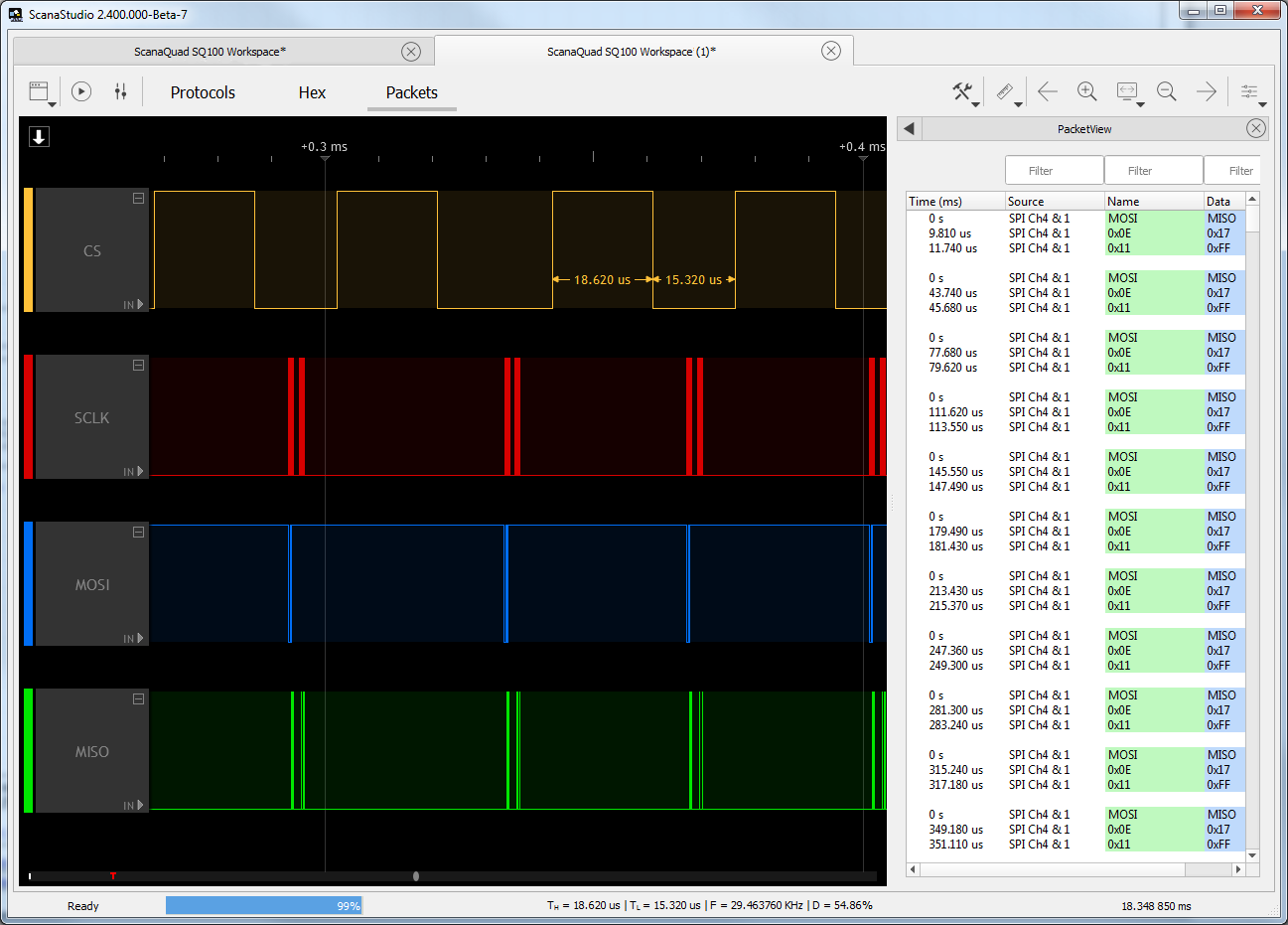If you are mainly involved in designing or repairing digital devices, a logic analyzer is more useful than an oscilloscope for tracing signal through circuits. However, does this mean you should rush out and buy a logic analyzer? The instruments from the leading manufacturers are too expensive for home use or startup businesses, and the low-cost alternatives don’t do what you want or have half-baked software. That situation is slowly starting to change.

The French company Ikalogic has been making logic analyzers modules since 2010 with a USB port for connection to a laptop or desktop PC. Nothing special, you might say, but late last year they launched a new series of four-channel logic analyzer modules. Why not eight or more channels? If you think about it a bit, the answer is clear: most modern microcontrollers and digital circuits use serial links to save space and pin counts. Sensors, EEPROMs, communication with the outside world – they all run with I²C, I²S, 1-Wire, USB and so on.
With all of these links you only need two, three or four lines, so why not limit yourself to a total of four channels? Ikalogic has worked this out nicely, and especially thanks to the integration of virtually all commonly used serial protocols into their software, you actually don’t need more channels with the ScanaQuad devices. If you nevertheless do require more, Ikalogic’s engineers have anticipated your need by allowing several analyzer modules to be operated in parallel with an accessory adapter, which gives you up to 24 channels.
The ScanaQuad series consists of four modules (SQ25, SQ50, SQ100 and SQ200), which mainly differ in the sampling rate. The number at the end of the type designation is the sampling rate in MHz per channel (for example, SQ25 means 25 MHz), regardless of the number of channels being used. Compared to the lower-end modules, the two top-end modules have a larger input voltage range (±15 V), more input and output configurations, and differential measurement capability.
All four ports are user definable – for example, they can be identified as the SCA and SCL lines of an I²C bus. Each port can also act as an output. An output can supply a pulse signal with adjustable frequency and duty cycle, but you can also define complex data sequences using JavaScript commands. Incidentally, that also applies to the decoder protocols – you can also create your own, but there are already a lot of predefined protocols to choose from.
The currently available protocols are:
- 1-Wire
- CAN
- DHT11/22
- DMX-512
- HC-SR04
- I²C
- I²S
- JTAG
- 4-bit LCD
- LIN
- Manchester
- Maple
- MIDI
- NMEA 0183
- nRF24L01
- Oregon Scientific
- Parallel Bus
- PWM
- SENT
- SPI
- SPI WIZnet W5100
- UART
- USB1.1
There is also built-in support for specific devices, such as some 1-Wire temperature sensors and I²C temperature and humidity sensors.
Practical experience
When the package arrived, we thought it was fairly small. But the biggest surprise came when we opened the package: the actual analyzer module measures just 5x5 cm (about 2x2 inches)!
Nevertheless, the small grey enclosure contains all the hardware necessary for a fast four-channel analyzer. The package also includes a USB connection cable and a five-lead measuring cable with probe clips. The accompanying ScanStudio software (available on the Ikalogic website for Windows, OS X and Linux) installs quickly.

The program is very intuitive, and after trying it out a while you quickly understand how the main functions work. Some things (creating a protocol, for example) are complicated, but you can clearly see that this program was written by technicians for technicians. Everything is logically organized.
When you launch the program you open a new or existing workspace, which is a window where you can view and configure the four channels. You can have several workspaces open at the same time, each configured with a different protocol or other parameters. That makes it very easy to switch between configurations; only the settings of the active window are active in the device. The four channels are displayed prominently, and you can disable one or more of them if you want to simplify things.
There is a configuration menu for setting a number of parameters for each input or output:
- the logic level to be measured
- whether the port is an input or an output
- open-drain or I²C I/O
- RS232 input
- the pull-down resistor value
- optionally a pull-up resistor
You can find a suitable setting for virtually every possible situation. The number of trigger options is nearly unlimited. Along with the choice of manual start, rising edge or falling edge, you can configure a series of levels and edges using a drag & drop menu. You can also enter a decimal, ASCII or hex value as a trigger value.
One thing you might miss is a free-running mode to quickly check whether a signal is present on a line. After the trigger event, the internal buffer of the analyzer is filled with data. The buffer size is 1 to 16 MB, depending on the model. The analyzer does not stream the data over USB, because a direct buffer in the device is much faster and the capacity is usually sufficient to allow you to track all the desired data. In the display window you can scroll through the buffer and zoom in or out.
You can set markers and make various sorts of measurements, including duty cycle measurement or counting the number of rising or falling edges between two markers. If you wish, you can also open an additional window to display the data in hex format or data packets with corresponding time stamps.
The longer you work with the ScanaQuad, the more you appreciate its simple but very extensive user interface. We actually didn’t find anything to complain about. If we had to comment on something, it might be the fairly complicated procedure for defining your own protocols. That’s something you really have to study, but we have to give credit to Ikalogic for providing a detailed guide for this on their website. The ScanaQuad is unquestionably good value for money, and which model you choose mainly depends on how fast the signals are in the circuits you work on. It certainly lives up to the saying “Good things come in small packages.”


